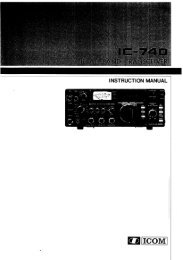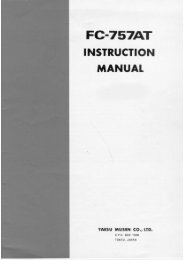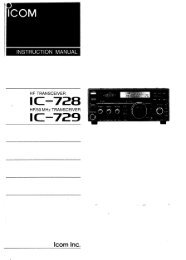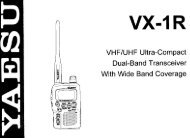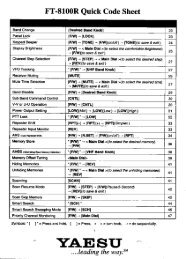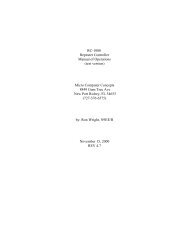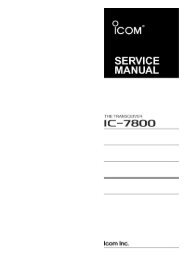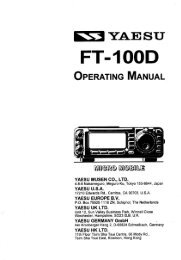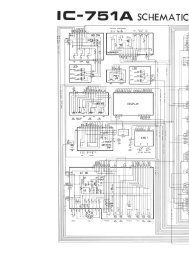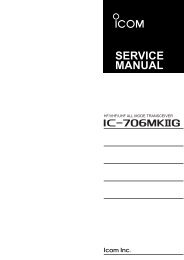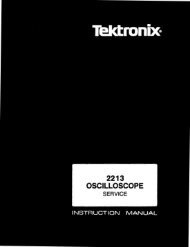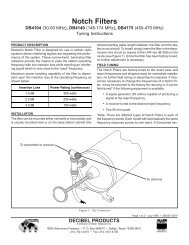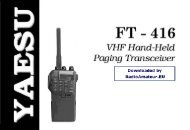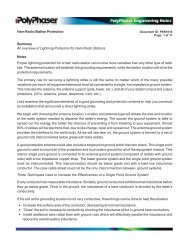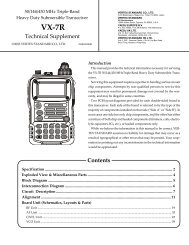Create successful ePaper yourself
Turn your PDF publications into a flip-book with our unique Google optimized e-Paper software.
While in SSB mode, the amplified signals from the buffer<br />
amplifier (Q1651) are then applied to the balanced modulator<br />
(<strong>IC</strong>201).<br />
While in AM/FM mode, the amplified signals from the buffer<br />
amplifier (Q1651) are applied to the limiter amplifier<br />
(<strong>IC</strong>1651b) and splatter filter (<strong>IC</strong>1651a). The signals are<br />
passed through the buffer amplifier ((<strong>IC</strong>1652a) and are then<br />
applied to the AM detector (<strong>IC</strong>1807d, D1652) in AM mode or<br />
to the varactor diode (D253) in FM mode.<br />
4-2-4 TRANSMIT IF AMPLIFIER CIRCUIT<br />
(MAIN UNIT)<br />
The modulated IF signal from a modulation circuit is applied<br />
to the IF amplifier circuit (Q1). The amplified IF signal is then<br />
applied to the VHF/UHF transmit circuit (PA unit) via the VHF<br />
/UHF switching circuit (D52, D53).<br />
The gain of the IF amplifier circuit (Q1) is controlled by the<br />
ALC amplifier circuit (<strong>IC</strong>1601b). Therefore, the IF amplifier<br />
is reduced when the output power increases.<br />
4-2-2 MODULATION CIRCUIT (MAIN UNIT)<br />
(1) FM mode<br />
The amplified audio signals from <strong>IC</strong>1701 are pre-emphasized<br />
and limited at <strong>IC</strong>1651b and then passed through the<br />
splatter filter (<strong>IC</strong>1651a). The filtered signals are then applied<br />
to the FM modulation circuit (D253) via the FM deviation<br />
level controller (<strong>IC</strong>1803 pins 21, 22) and buffer amplifier<br />
(<strong>IC</strong>1652a). Also, subaudible tone signals from the CPU<br />
(DISPLAY board; <strong>IC</strong>1 pin 4) are applied to the FM modulation<br />
circuit (D253) via the splatter filter (<strong>IC</strong>1651a).<br />
The FM modulation circuit changes the generating frequency<br />
of the FM local oscillator (Q254, X251) to generate an FM<br />
signal. The modulated IF signal is passed through the RF<br />
limiter (Q253) and then applied to the transmit IF amplifier<br />
circuit.<br />
When 9600 bps mode is selected, audio signals from the<br />
ACC connector bypass the amplifiers and are applied to<br />
<strong>IC</strong>1654a directly via the external modulation switch (<strong>IC</strong>1531,<br />
pins 12, 1). In such cases, the deviation detector (<strong>IC</strong>1807d)<br />
cuts off the audio line when over modulation is detected.<br />
(2) SSB and CW modes<br />
The amplified audio signals from Q1651 are mixed with BFO<br />
signals at the balanced mixer circuit (<strong>IC</strong>201) to produce a 10<br />
MHz IF signal. The mixed signal is still a DSB signal, therefore,<br />
the mixed signal passes through bandpass filter circuit<br />
(FI151) to suppress unwanted side band signals. The filtered<br />
signal is applied to the transmit IF amplifier circuit<br />
• Transmit IF frequencies<br />
Mode<br />
USB<br />
LSB<br />
CW<br />
Transmit IF signal<br />
10.8485 MHz<br />
10.8515 MHz<br />
10.8491 MHz<br />
4-2-3 CW KEYING CIRCUIT (MAIN UNIT)<br />
When the CW key is closed, control signal is output from<br />
CPU (LOG<strong>IC</strong> unit) and controls break-in operation, the side<br />
tone signal.<br />
Keying signals (DOT and DASH) from the [KEY] jack<br />
(J1401) are applied to the CPU (DISPLAY board; <strong>IC</strong>1, pins<br />
49, 48 respectively), and the CPU outputs a CW control signal<br />
(KDS1) from pin 21. The CW control signal is applied to<br />
the balanced mixer (<strong>IC</strong>201) via Q201, D201, D207 to unbalance<br />
the <strong>IC</strong>201 input bias voltage and creates a carrier signal.<br />
R202 determines the transmit delay timing.<br />
4-2-5 RF CIRCUIT (PA UNIT)<br />
The RF circuit consists of mixer and drive amplifiers to<br />
obtain the desired frequency and level needed at a PA circuit,<br />
respectively.<br />
(1) VHF band<br />
The IF signal from the MAIN unit (P501) is mixed with an LO<br />
signal from the VHF VCO circuit (PLL unit; Q191,<br />
D191–D194) at the double-balanced mixer circuit (Q501,<br />
Q502, D502) to be converted into VHF transmit frequency.<br />
The mixed signal is passed through the attenuator<br />
(R512–R514) and two-stage tunable bandpass filter (D503,<br />
L533 and D504, L504) to suppress spurious components.<br />
The filtered signals are then amplified at the YGR amplifier<br />
(<strong>IC</strong>501) and passed through the attenuator (R562–R531)<br />
and another two-stage tunable bandpass filter (D641, L641<br />
and D642, L642)<br />
The amplified and filtered RF signal is applied to the drive<br />
amplifier circuit that is used VHF and UHF signals commonly.<br />
(2) UHF band<br />
The IF signal from the MAIN unit (P1) is mixed with a 2nd LO<br />
signal at the double-balanced mixer circuit (Q1, Q2) to produce<br />
a 2nd IF signal (71.25 MHz). The 2nd LO signal (60.4<br />
MHz) is generated at the reference oscillator and doubler<br />
circuit (PLL unit; X512, Q551) via LO amplifier (<strong>IC</strong>40). The<br />
2nd IF signal is amplified at the buffer amplifier (Q3) via the<br />
bandpass filter circuit (L3, L4, C12, C13, C15–C17, C24,<br />
C26). The amplified 2nd IF signal is applied to the 1st mixer<br />
circuit (D190, L190, L191) passing through the attenuator<br />
(R12–R14) and low-pass filter (L381, L382, C381–C383).<br />
The 1st mixer circuit (D190, L190, L191) converts the 2nd IF<br />
signal into a UHF transmit frequency with a 1st LO signal<br />
from the UHF VCO circuit (PLL unit; Q391, D391–D394).<br />
The converted RF signal is passed through the bandpass filter<br />
(FI200 and FI201) where unwanted LO signal emission<br />
is reduced. The filtered signal is attenuated at R204–R206<br />
and amplified at the YGR amplifier (<strong>IC</strong>200), and is then<br />
applied to the drive amplifier circuit via the band pass filter<br />
(FI202) and another YGR amplifier (Q200).<br />
4-2-6 DRIVE AMPLIFIER CIRCUIT (PA UNIT)<br />
The drive amplifier circuit amplifies RF signals from the VHF<br />
or UHF RF circuit to obtain a level needed at the power<br />
amplifier circuit. One drive amplifier circuit is commonly used<br />
for both VHF and UHF band signals.<br />
The signals from the VHF or UHF RF circuit are amplified at<br />
the drive amplifier circuit (Q101, Q121, Q131, DRV board;<br />
Q930). The amplified VHF signals are passed through the<br />
4 - 4



